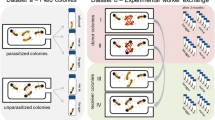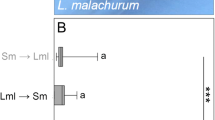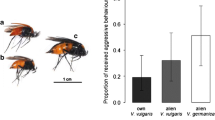Abstract
A challenge for parasites is how to evade the sophisticated detection and rejection abilities of potential hosts. Many studies have shown how insect social parasites overcome host recognition systems and successfully enter host colonies. However, once a social parasite has successfully usurped an alien nest, its brood still face the challenge of avoiding host recognition. How immature stages of parasites fool the hosts has been little studied in social insects, though this has been deeply investigated in birds. We look at how larvae of the paper wasp obligate social parasite Polistes sulcifer fool their hosts. We focus on cuticular hydrocarbons (CHCs), which are keys for adult recognition, and use behavioral recognition assays. Parasite larvae might camouflage themselves either by underproducing CHCs (odorless hypothesis) or by acquiring a chemical profile that matches that of their hosts. GC/MS analyses show that parasite larvae do not have lower levels of CHCs and that their CHCs profile is similar to the host larval profile but shows a reduced colony specificity. Behavioral tests show that the hosts discriminate against alien conspecific larvae from different colonies but are more tolerant towards parasite larvae. Our results demonstrate that parasite larvae have evolved a host larval profile, which overcomes the host colony recognition system probably because of the lower proportion of branched compounds compared to host larvae. In some ways, this is a similar hypothesis to the odorless hypothesis, but it assumes that the parasite larvae are covered by a chemical blend that is not meaningful to the host.





Similar content being viewed by others
References
Akino T, Knapp JJ, Thomas JA, Elmes GW (1999) Chemical mimicry and host specificity in the butterfly Maculinea rebeli, a social parasite of Myrmica ant colonies. Proc R Soc Lond B 266:1419–1426
Bagnères A-G, Lorenzi MC, Dusticier G, Turillazzi S, Clément JL (1996) Chemical usurpation of a nest by paper wasp parasites. Science 272:889–892
Bonavita-Cougourdan A, Theraulaz G, Bagnères AG, Roux M, Pratte M, Provost E, Clément JL (1991) Cuticular hydrocarbons, social organization and ovarian development in a polistine wasp: Polistes dominulus Christ. Comp Biochem Physiol 100B:667–680
Cervo R (1990) Il parassitismo sociale nei Polistes (PhD dissertation). University of Florence, Florence
Cervo R (1994) Morphological adaptations to the parasitic life in Polistes sulcifer and Polistes atrimandibularis (Hymenoptera, Vespidae). Ethol Ecol Evol (Spec. issue) 3:61–66
Cervo R (2006) An overview on Polistes parasites and their hosts. Ann Zool Fenn 43:531–549
Cervo R, Dani FR (1996) Social parasitism and its evolution in Polistes. In: Turillazzi S, West-Eberhard MJ (eds) Natural history and evolution of paper-wasps. Oxford University Press, Oxford, pp 98–112
Cervo R, Macinai V, Dechigi F, Turillazzi S (2004) Fast growth of immature brood in a social parasite wasp: a convergent evolution between avian and insect cuckoos. Am Nat 164:814–820
Cotoneschi C, Dani FR, Cervo R, Sledge MF, Turillazzi S (2007) Polistes dominulus (Hymenoptera: Vespidae) larvae possess their own chemical signatures. J Insect Physiol 53(9):954–963
Dani FR, Morgan ED, Turillazzi S (1996) Dufour gland secretion of Polistes wasp: chemical composition and possible involvement in nestmate recognition (Hymenoptera: Vespidae). J Insect Physiol 42:541–548
Dani FR, Jones GR, Destri S, Spencer SH, Turillazzi S (2001) Deciphering recognition signature within the cuticular chemical profile of paper wasps. Anim Behav 62:165–171
Dapporto L, Cervo R, Sledge MF, Turillazzi S (2004) Rank integration in dominance hierarchies of host colonies by the paper wasp social parasite Polistes sulcifer (Hymenoptera, Vespidae). J Insect Physiol 50:217–223
Dettner K, Liepert C (1994) Chemical mimicry and camouflage. Annu Rev Entomol 39:129–154
Elmes GW, Barr B, Thomas JA, Clarke RT (1999) Extreme host specificity by Microdon mutabilis (Diptera: Syrphidae), a social parasite of ants. Proc R Soc Lond B 266:447–453
Falush D, Stephens M, Pritchard JK (2003) Inference of population structure using multilocus genotype data: linked loci and correlated allele frequencies. Genetics 164:1567–1587
Gamboa GJ (1996) Kin recognition in social wasps. In: Turillazzi S, West-Eberhard MJ (eds) Natural history and evolution of paper-wasps. Oxford University Press, Oxford, pp 161–17
Gamboa GJ (2004) Kin recognition in eusocial wasps. Ann Zool Fennici 41:789–808
Henshaw M (2000) Microsatellite loci for the social wasp Polistes dominulus and their application in other wasps. Mol Ecol 9:2155–2157
Howard RW, Stanley-Samuelson DW, Akre R (1990) Biosynthesis and chemical mimicry of cuticular hydrocarbons from the obligate predato, Microdon albicomatus Novak (Diptera: Syrphidae) and its ant prey, Myrmica incompleta Provancher (Hymenoptera: Formicidae). J Kans Entomol Soc 63:437–443
Johnson CA, Topoff H, Vander Meer RK, Lavine B (2005) Do these eggs smell funny to you?: an experimental study of egg discrimination by hosts of the social parasite Polyergus breviceps (Hymenoptera: Formicidae). Behav Ecol Sociobiol 5:245–255
Lenoir A, D’Ettorre P, Errard C (2001) Chemical ecology and social parasitism in ants. Annu Rev Entomol 46:573–99
Lorenzi MC (2003) Social wasp parasites affect the nestmate recognition abilities of their hosts (Polistes atrimandibularis and P. biglumis, Hymenoptera, Vespidae). Insect Soc 50:82–87
Lorenzi MC (2006) The result of an arm race: the chemical strategies of Polistes social parasites. Ann Zool Fenn 43:550–563
Lorenzi MC, Bagnères A-G (2002) Concealing identity and mimicking hosts: adual chemical strategy for a single social parasite? (Polistes atrimandibularis, Hymenoptera: Vespidae). Parasitology 125:507–512
Lorenzi MC, Filippone F (2000) Opportunistic discrimination of alien eggs by social wasps (Polistes biglumis, Hymenoptera Vespidae): a defense against social parasitism? Behav Ecol Sociobiol 48:402–406
Lorenzi MC, Bagnères A-G, Clément JL (1996) The role of cuticular hydrocarbons in social societies: is it the same in paper wasps? In: Turillazzi S, West-Eberhard MJ (eds) Natural history and evolution of paper-wasps. Oxford University Press, Oxford, pp 178–189
Lorenzi MC, Cervo R, Turillazzi S (1992) Effects of social parasitism of Polistes atrimandibularis on the colony cycle and brood production of Polistes biglumis bimaculatus (Hymenoptera, Vespidae). Boll Zool 59:267–271
Lorenzi MC, Cervo R, Zacchi F, Turillazzi S, Bagnères A-G (2004) Dynamics of chemical mimicry in the social parasite wasp Polistes semenowi (Hymenoptera: Vespidae). Parasitology 129:643–651
Mundry R, Fischer J (1998) Use of statistical programs for non parametric tests of small sample often leads to incorrect P value: examples from Animal Behavior. Anim Behav 56:256–259
Panek LM, Gamboa GJ (2000) Queens of the paper wasp Polistes fuscatus (Hymenoptera: Vespidae) discriminate among larvae on the basis of relatedness. Ethology 106:159–170
Pritchard JK, Stephens M, Donnelly P (2000) Inference of population structure using multilocus genotype data. Genetics 155:945–959
Schonrogge K, Wardlaw JC, Peters AJ, Everett S, Thomas JA, Elmes GW (2004) Changes in chemical signature and host specificity from larval retrieval to full social integration in the myrmecophilous butterfly Maculinea rebeli. J Chem Ecol 30:91–107
Singer TL, Espelie KE (1992) Social wasps use nest paper hydrocarbons for nestmate recognition. Anim Behav 44:63–68
Singer TL, Espelie KE (1996) Nest surface hydrocarbons facilitate nestmate recognition for Polistes metricus Say. J Insect Behav 9:857–870
Singer TL, Espelie KE, Gamboa GJ (1998) Nest and nestmate discrimination in independent-founding paper wasps. In: Vander Meer RK, Breed MD, Winston M, Espelie K (eds) Pheromone communication in social insects: ants, bees, wasps, and termites. Westview Press, Boulder, CO, pp 104–125
Sledge MF, Dani FR, Cervo R, Dapporto L, Turillazzi S (2001) Recognition of social parasites as nest-mates: adoption of colony-specific host cuticular odors by the paper wasp parasite Polistes sulcifer. Proc R Soc Lond B 268:2253–2260
Strassmann JE, Solís CR, Peters JM, Queller DC (1996) Strategies for finding and using highly polymorphic DNA microsatellite loci for studies of genetic relatedness and pedigrees. In: Ferraris JD, Palumbi SR (eds) Molecular zoology: advances, strategies and protocols. Wiley, New York, pp 163–180 528–549
Strassmann JE, Seppä P, Queller DC (2000) Absence of within-colony kin discrimination: foundresses of the social wasp, Polistes carolina, do not prefer their own larvae. Naturwissenschaften 87:266–269
Turillazzi S, Sledge MF, Dani FR, Cervo R, Massolo A, Fondelli L (2000) Social hackers: integration in the host chemical recognition system by a paper wasp social parasite. Naturwissenschaften 87:172–176
Acknowledgments
We thank Wendy Castle for help genotyping larvae and Marcus Kronforst for his support with the genetic data analysis, particularly with the STRUCTURE program. We thank Mr. Daniele Melotti for permission to collect wasps from his property. We are grateful to the anonymous referees for their very helpful comments. The experiments reported comply with the current laws of the countries in which they were performed. This research was based on work supported by University of Florence and by the US National Science Foundation under Grant IBN-9975351. Financial support was provided by the Ente Cassa di Risparmio through a fellowship to FRD (within the grant 2003/0964) and a fellowship “Ficai” to CC.
Author information
Authors and Affiliations
Corresponding author
Additional information
Communicated by K. Ross
Rights and permissions
About this article
Cite this article
Cervo, R., Dani, F.R., Cotoneschi, C. et al. Why are larvae of the social parasite wasp Polistes sulcifer not removed from the host nest?. Behav Ecol Sociobiol 62, 1319–1331 (2008). https://doi.org/10.1007/s00265-008-0560-1
Received:
Revised:
Accepted:
Published:
Issue Date:
DOI: https://doi.org/10.1007/s00265-008-0560-1




